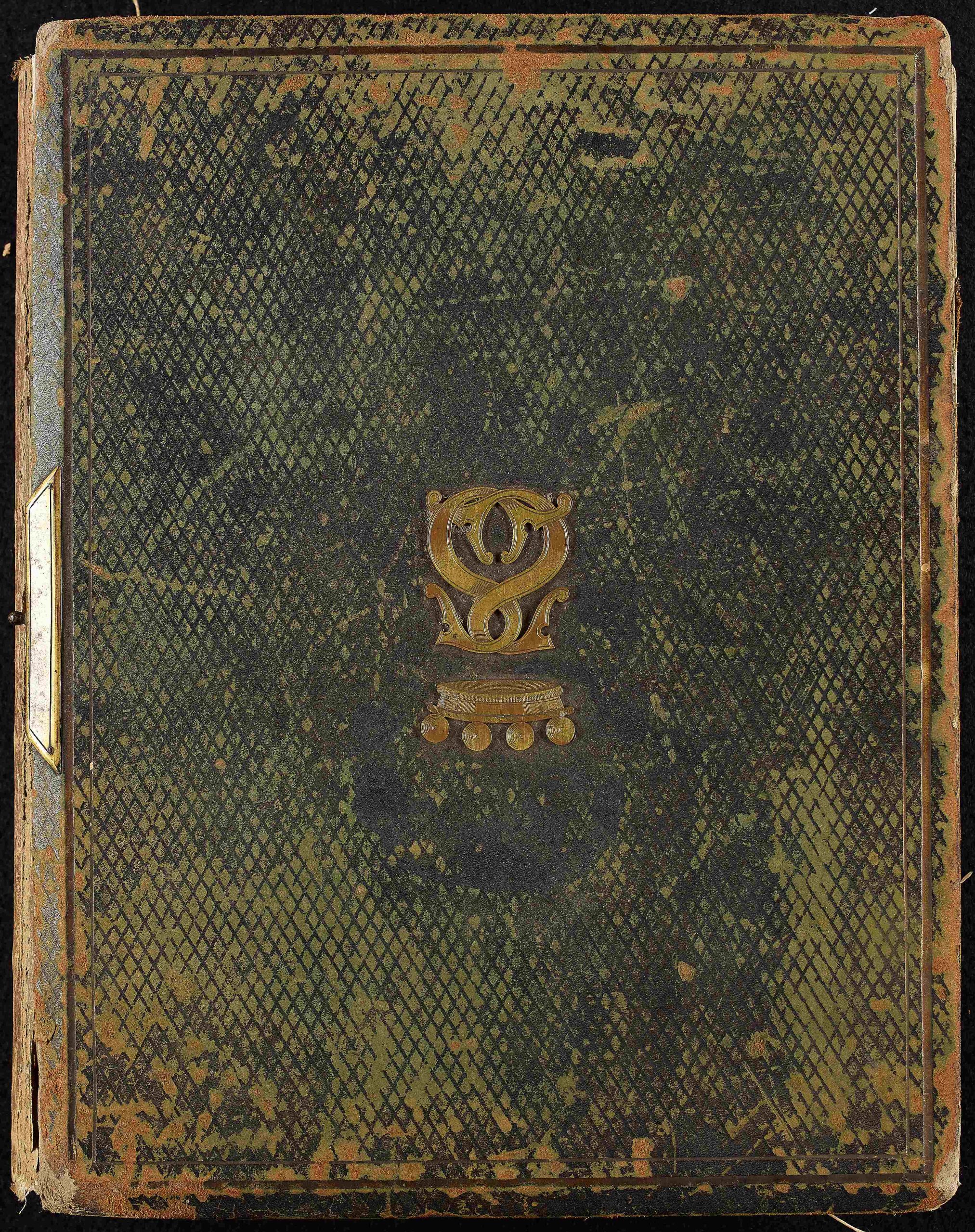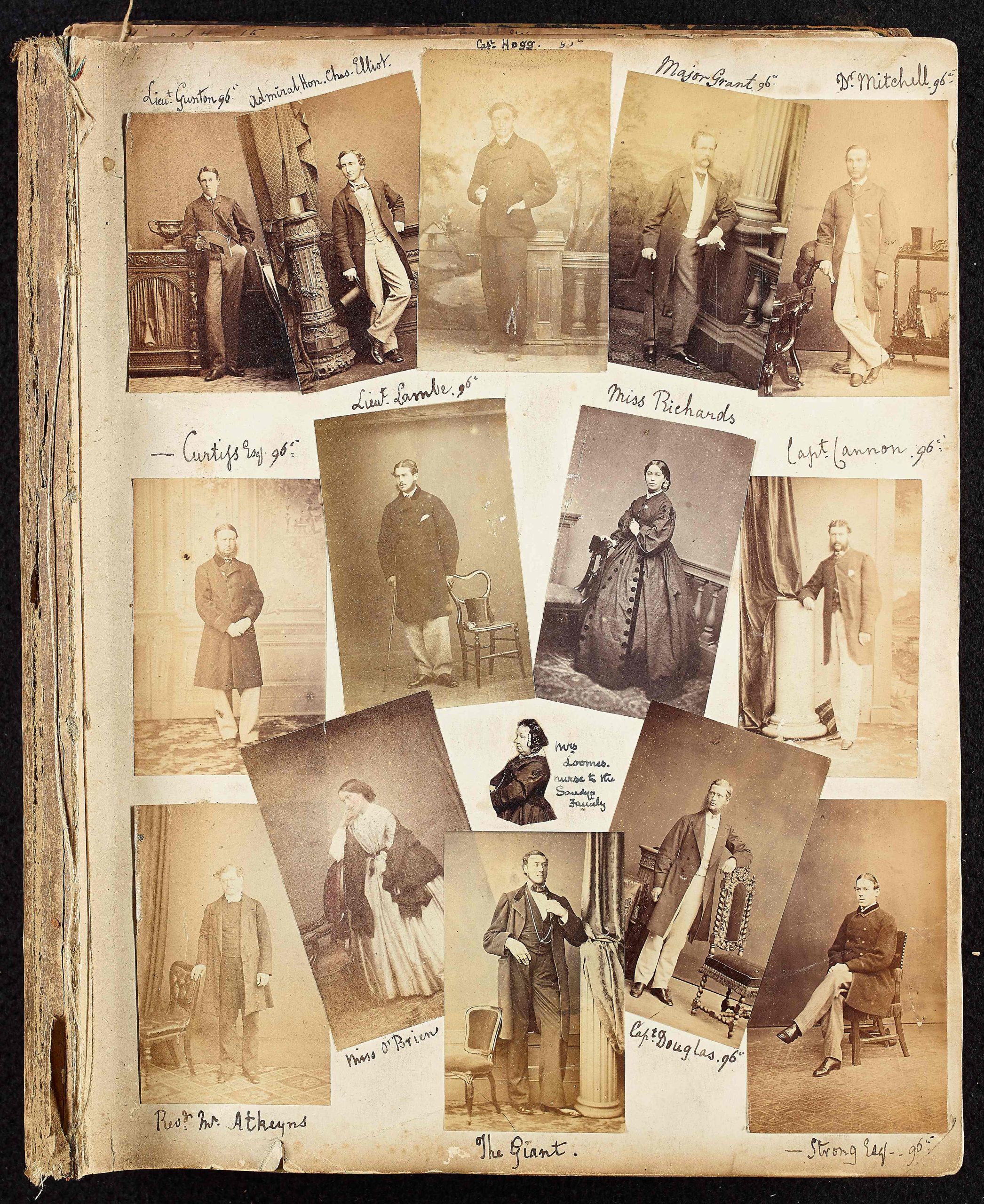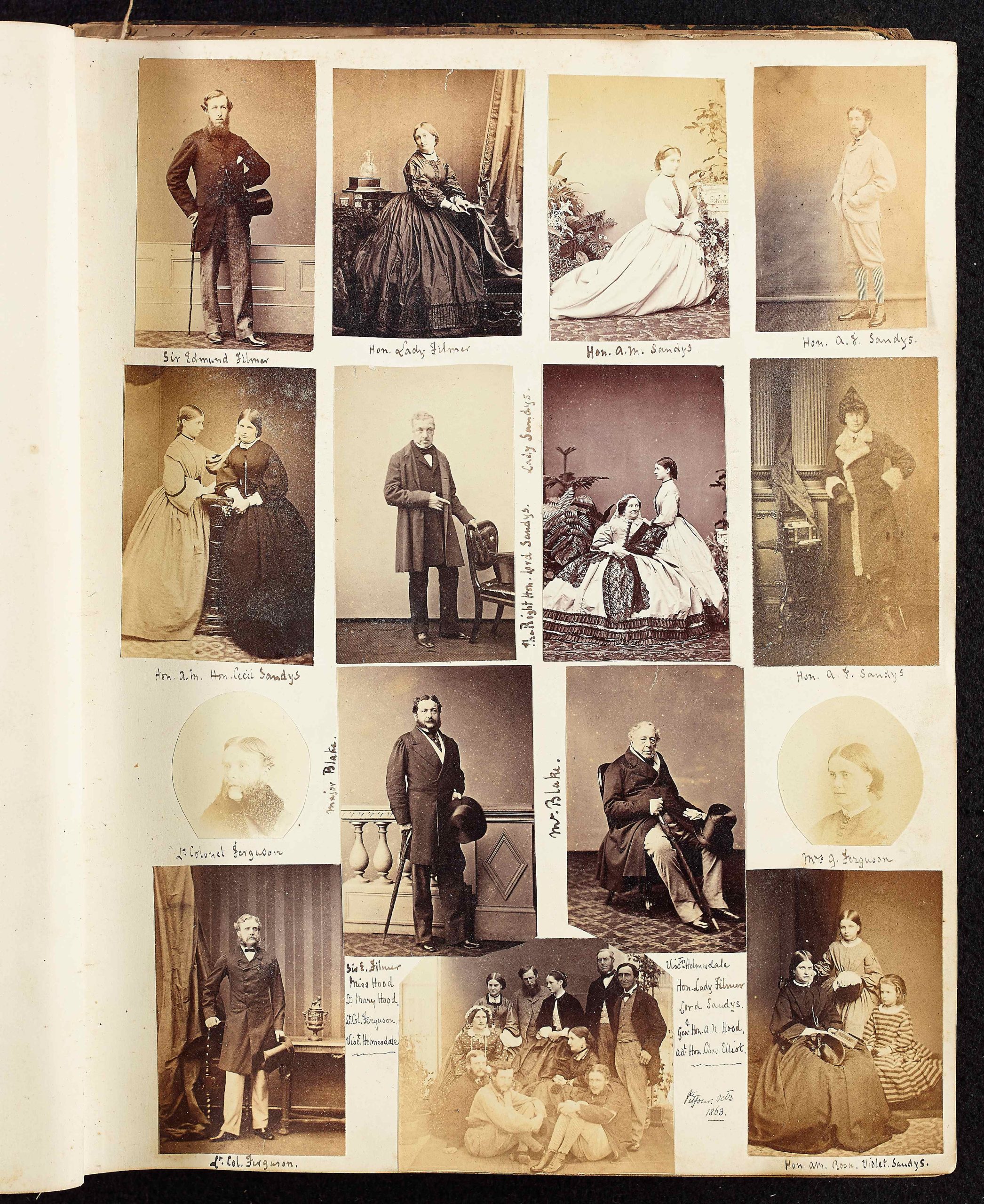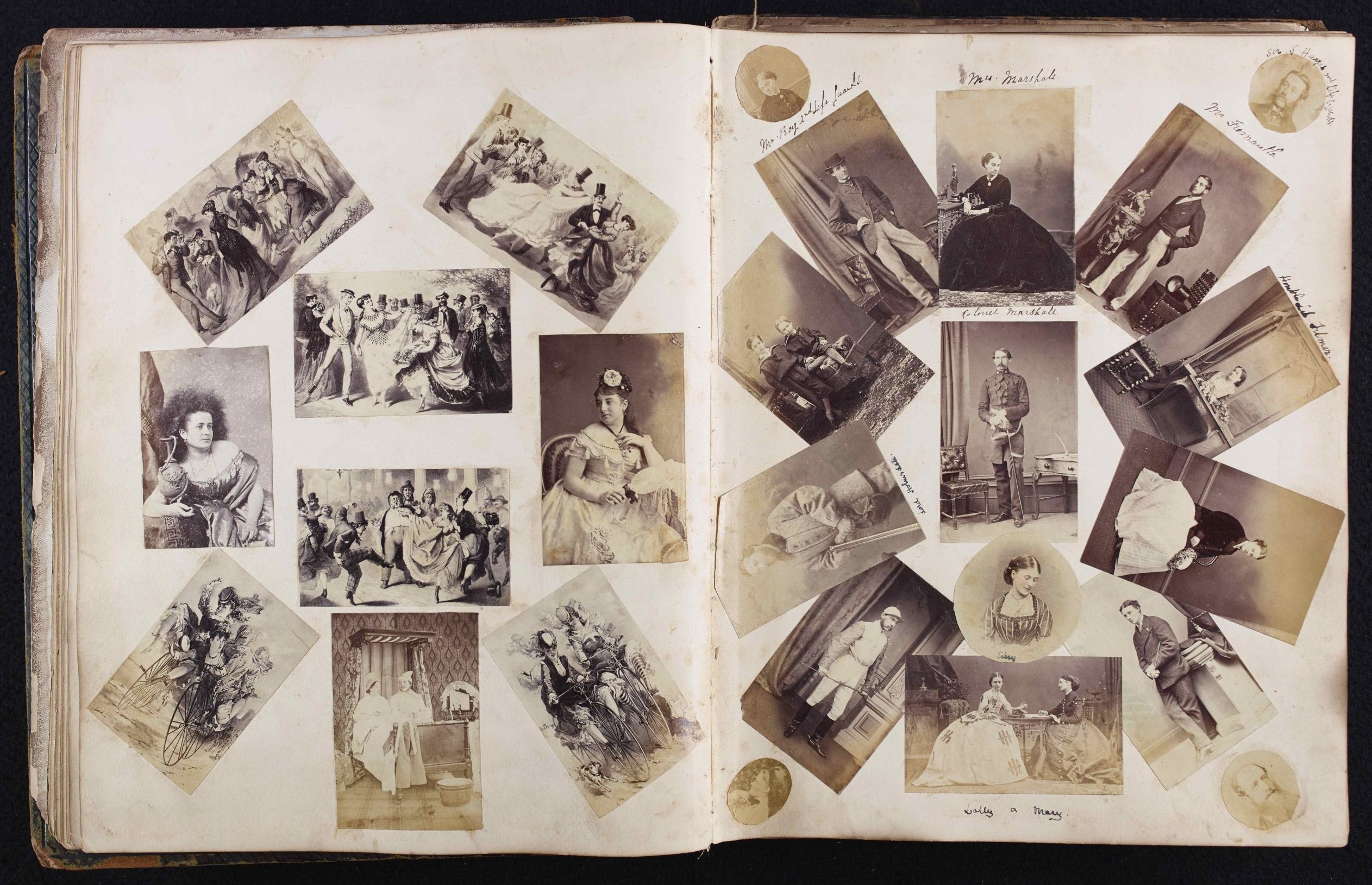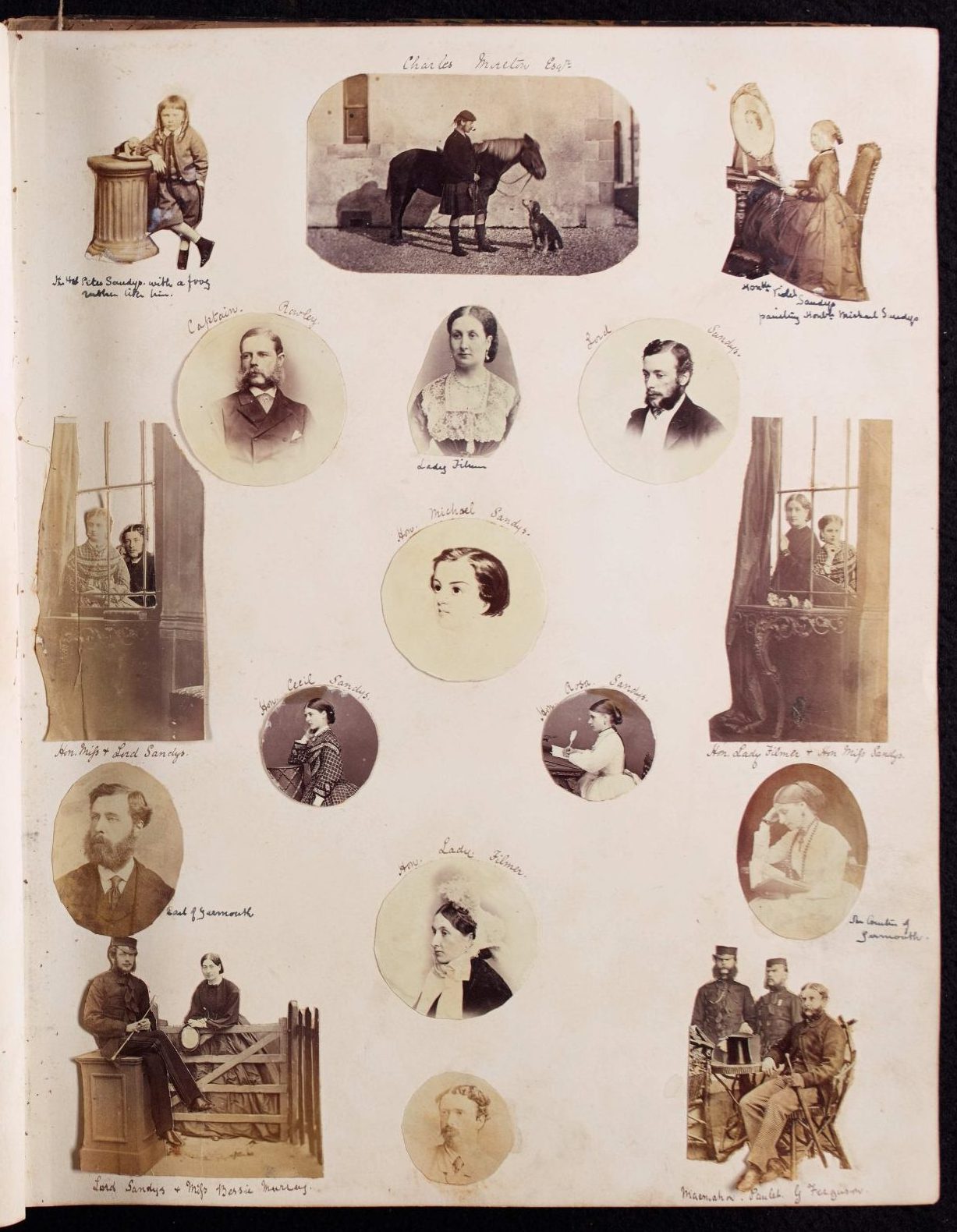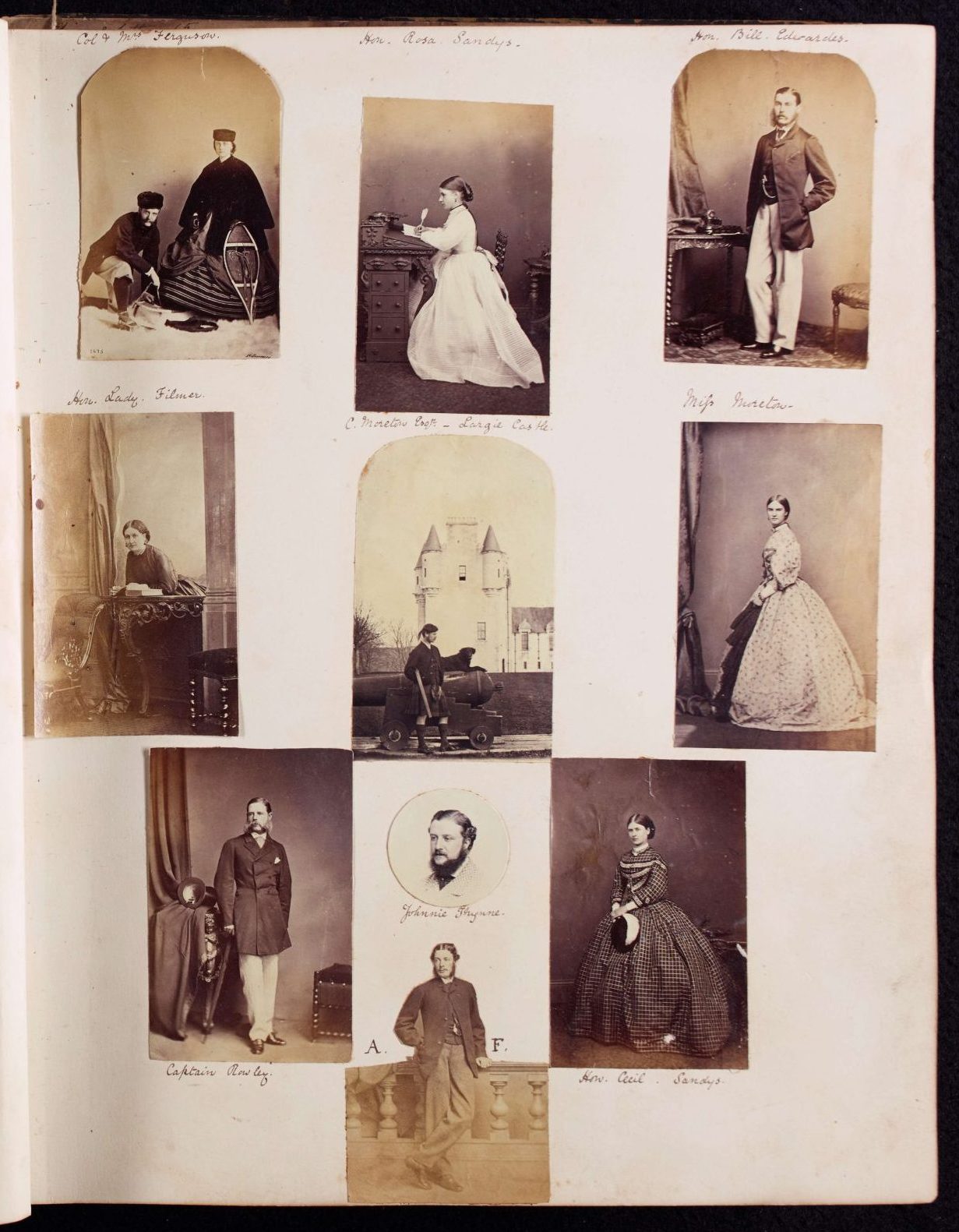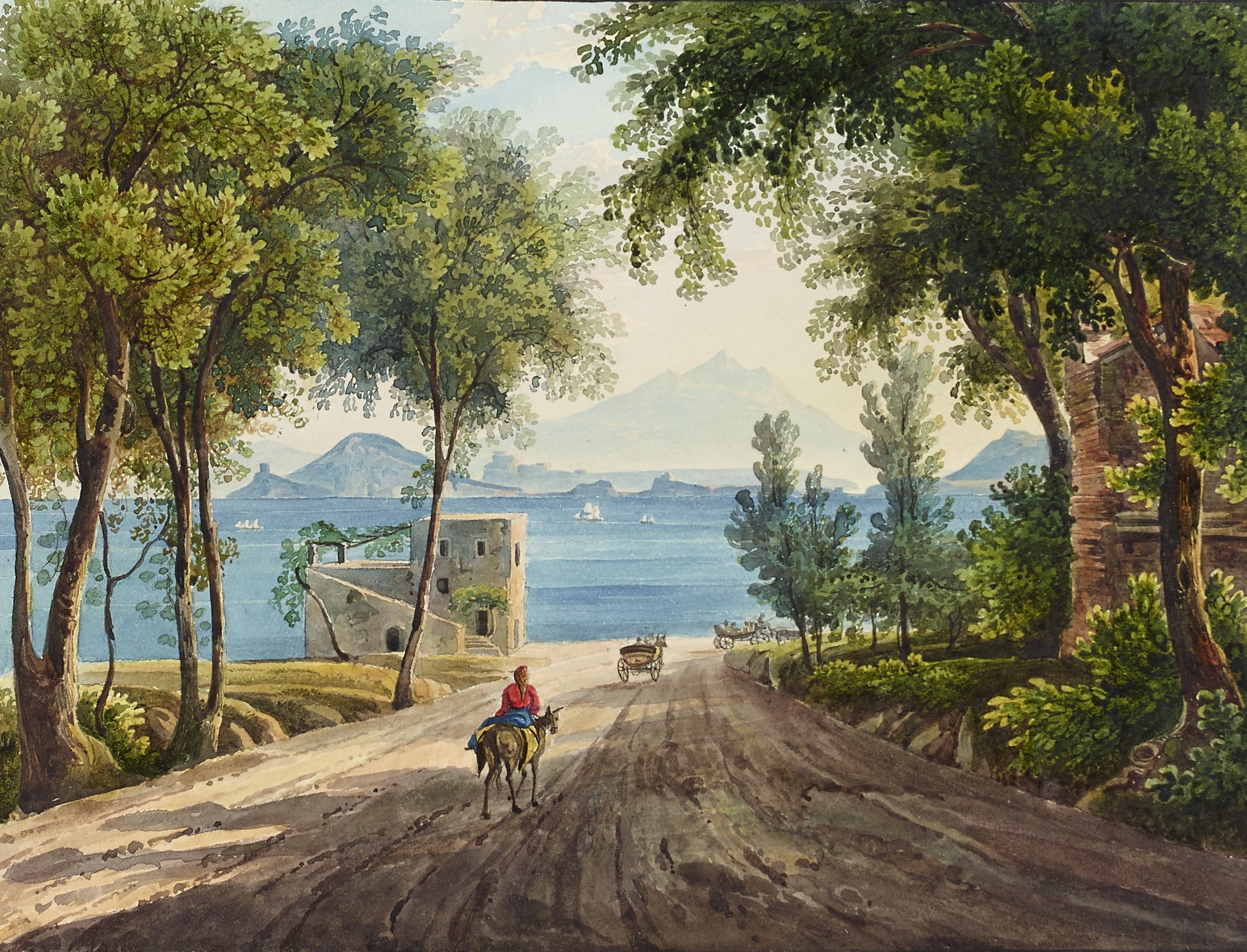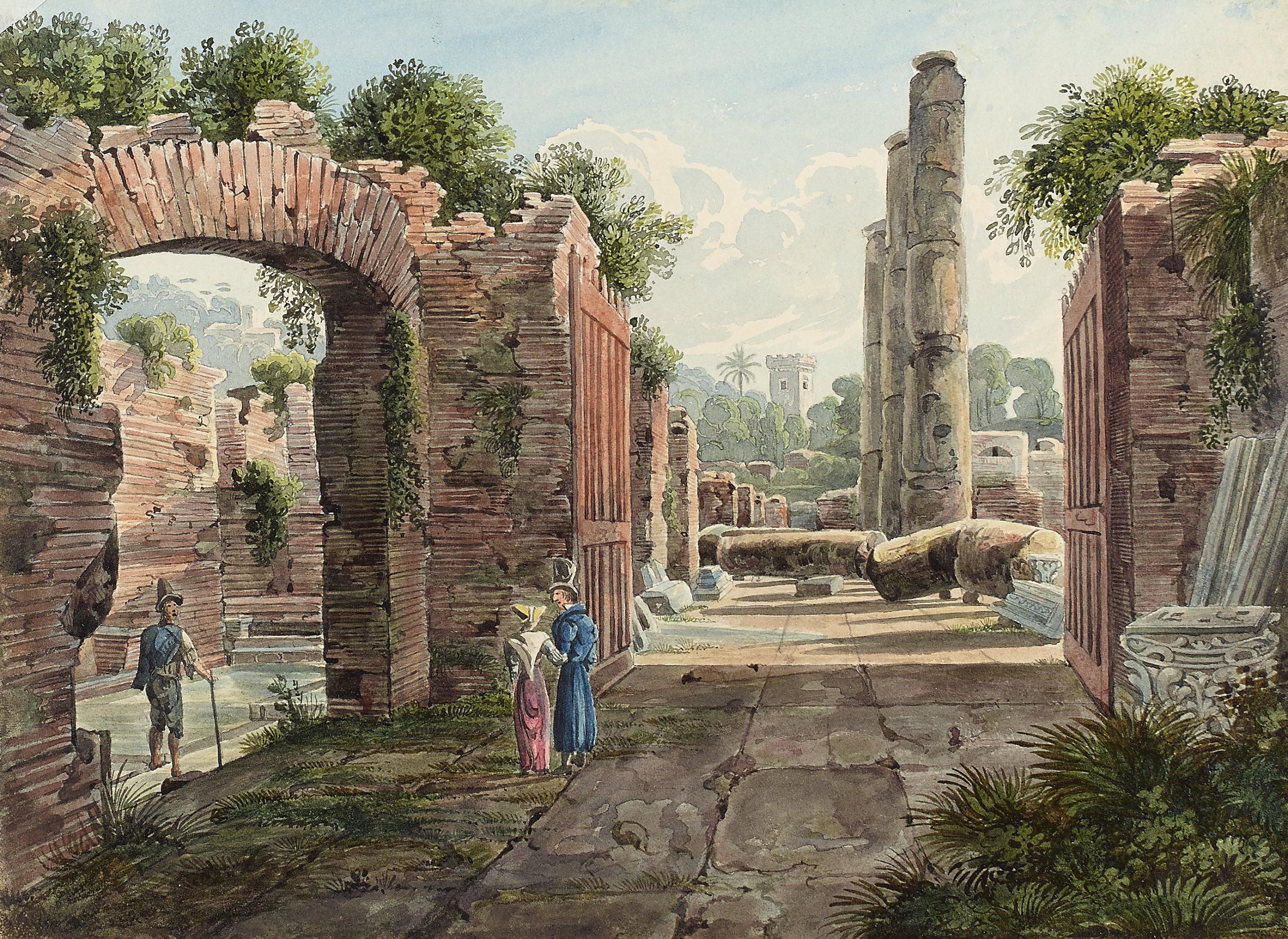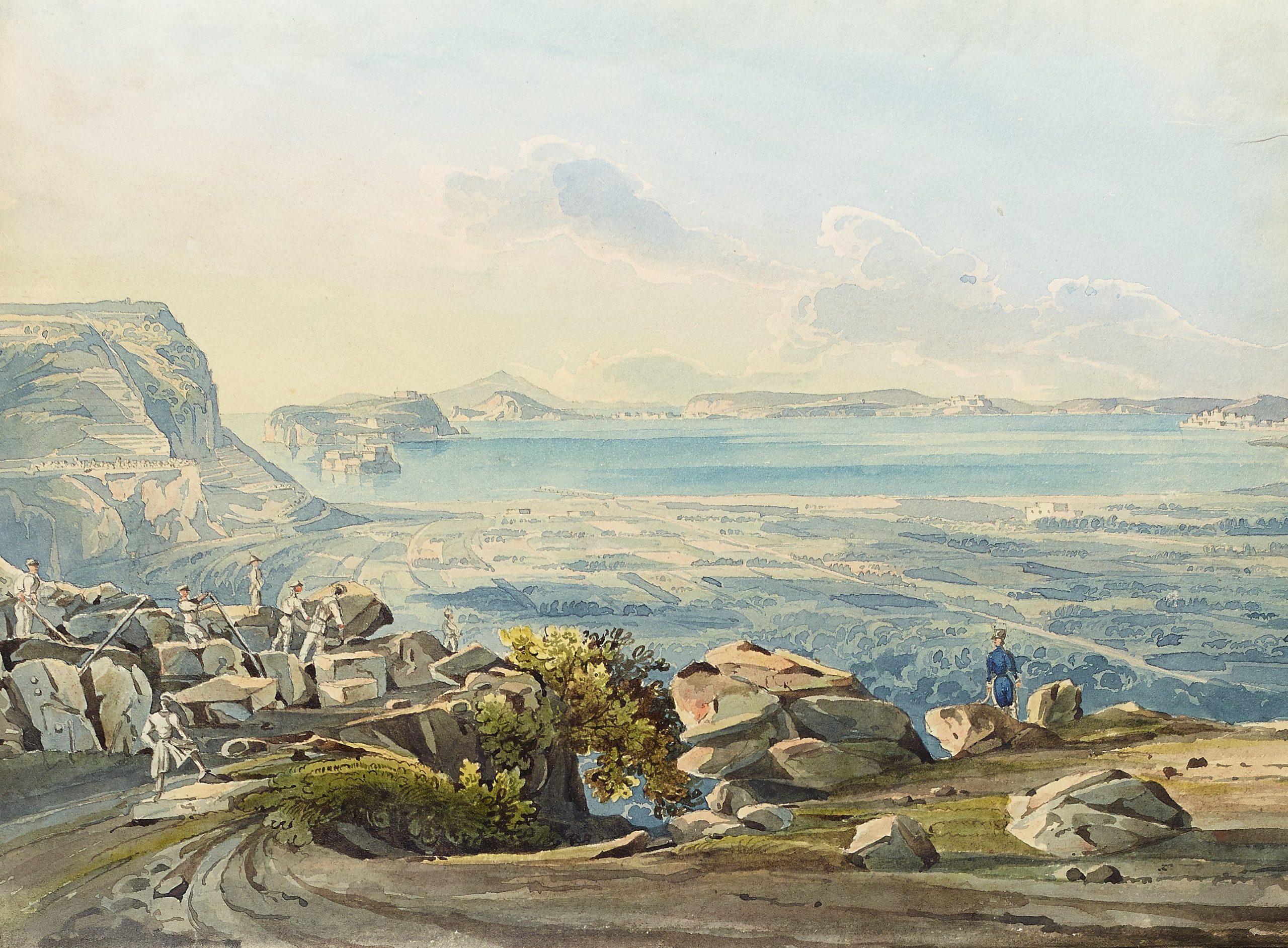Sandys Archive
The history of the Sandys family of Ombersley dates back almost 400 years. Ombersley Court – the impressive, listed manor and estate set in the Worcestershire countryside, home to the titled family since 1614 – forms the backdrop to their story; one that is of both local and national interest. When the late Lord Sandys, the 7th Baron, Richard Hill, passed in 2013, the manor was sold and its archive – the material left at the Court following his death – was deposited with Worcestershire Archive and Archaeology Service (WAAS). Evidencing the lives of the eminent Sandys and subsequent Hill families, the contents of the archive referred to is a treasure trove of records that honour the late Baron and his predecessors.
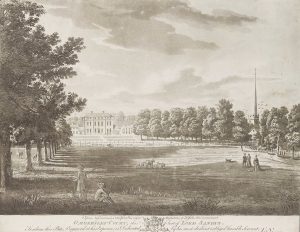
Copy of an engraving of Ombersley Court ‘the seat of Lord Sandys’ by V. Green, front elevation, 18th century – Reference Number: 899:156 WPS8349
Received in 2023, this collection is now the subject of a two-year project funded by the Ombersley Conservation Trust (OTC) – the charity set up by the 7th Baron and Baroness Sandys to preserve the historic material and contents of Ombersley Court. The aims of the project are two-fold: to complete the cataloguing of the family papers whilst also facilitating the promotion, publicity and use of the archive through a range of learning and outreach activities to raise awareness of its contents. Aware that they hold an important archive – it is unusual to have retained manorial records from the Medieval through to the Victorian Era, for instance – a spokesperson for the Ombersley Conservation Trust said:
“Trustees would like to ensure that it becomes readily accessible for research. We are looking forward to following the progress of this project and learning more about Ombersley and the Sandys family.”
Depositing the collection at The Hive for safekeeping will ensure its use by a full range of researchers both in our searchroom and online. As a result, the OTC have generously supported WAAS with the costs for the project.
The contents of the archive include: court rolls from 1272 – with some extracts dating back to 1191, accounts, correspondence, deeds and estate records concerning property in Worcestershire and around the UK, wills, maps, plans and household records. As well as an array of family and personal papers dating from the 17th to the 20th century. Fragments of Ombersley Court’s past, the collection sheds light on the fascinating history of a house and its inhabitants – whose complex lineage and cast of characters included a steady succession of MPs, members of the clergy and cousins who fought on opposing sides of the English Civil War. One family member also served in Wellington’s army during the Peninsular War and Battle of Waterloo.
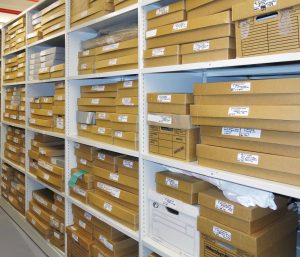
In-situ, the Sandys Archive now at The Hive
It makes sense that the archive has come to WAAS. The first archive collections of the Sandys family were deposited here in 1938, and the late Lord Sandys was a keen supporter of what was then Worcestershire Record Office and the first president of our Friends committee. Dr Adrian Gregson, County Archivist, said:
“We are very pleased to partner with the Ombersley Conservation Trust on this project […] I remember meeting him [Lord Sandys] as the first president of our Friends committee.”
Prior to his passing, this Lord Sandys also deposited by way of permanent loan several existing earlier records for the Sandys of Ombersley, which will be made available on our online catalogue as part of this project.
We’ll be updating this page as the project progresses with details of interesting records we find or stories we uncover as we catalogue; as well as information on any events or activities organised down the line once the project is underway.
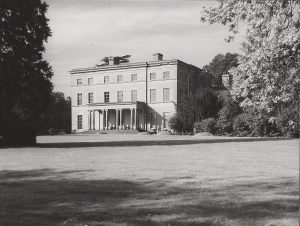
Ombersley Court in 1962 – Reference Number: 899:156 WPS26439 © C V Hancock
Sandys records at Worcestershire Archives
Already catalogued and in our collection at The Hive are a number of important records concerning the Sandys family. So what do we have and what stories do they tell?
Of whom Augusta Anne (Gussie) (nee Des Voeux) – wife of Augustus Fredrick Arthur 4th Baron Sandys – was, little is known. Possibly a talented ceramicist, she lived in Brighton and Leamington prior to her marriage, where she was ‘lightly spoken of’ on account of rumours she had given birth to a child and acted improperly with a married man. Such ‘dreadful falsehoods’ her family emphatically denied.
When Augustus and Augusta married in 1872, the so-called Sandys affair scandal saw members of the former’s family refuse to attend their wedding, and meant Augusta was socially shunned. Quite unfairly, too, given her husband later fathered a son with his chambermaid. Indeed, the rumours about Augusta were never substantiated, whilst Lord Sandys’ love child lived nearby.
Born in 1892, Frederick Richard Warner, known as Richard, was raised by his grandparents in Uphampton Lane, in Ombersley. After his birth, his mother Rose Warner – previously employed at Ombersley Court – moved away and married. We know that on Lord and Lady Sandys’ request, Richard would occasionally visit them with his grandmother. However, after Lord Sandys death any involvement (and any assets paid) between Richard and the Sandys family ended. Richard’s birth contradicted Augusta’s, perhaps naïve, assumption that her husband was in fact impotent since they seemed unable to have a child.
Our archive holds correspondence between Lord Sandys, Lord Lyttelton, Sir John Pakington, Sir Charles Douglas and Sir William Paulet relating to the ‘most serious of rumours in Worcestershire [that] Lady Sandys, when a single woman, [had] had a child.’ In the first letter in a subsequently printed copy intended for Lord and Lady Sandys private consultation, Lyttleton writes to Sandys’ mother, Louisa, that it is ‘with the utmost regret…that after much consideration and consultation with others – Lady Lyttleton and myself will not be able to receive or visit Lady Sandys’.
In response, Douglas (Augusta’s white knight) and Paulet (her uncle) ask Lyttelton to speak personally with Lord and Lady Sandys before arriving at any prejudicial conclusion. What follows is a fierce back and forth that ultimately descends into a tit for tat on ‘mere matters of opinion’. Whilst Douglas argues Augusta did ‘nothing to forfeit her station in society’, Lyttelton and Pakington claim they ‘acted according to well established rules of much importance to social morality’. ‘We do not deny that “rumours” such as you have described exist’, Douglas writes to Lyttelton, ‘[but] you will find that some are false and others exaggerated’. But ‘what were we supposed to do?’, Lyttelton protests, ‘the lady who was the subject of these disparaging rumours and family differences was coming to us as a nobleman’s bride’. In handwritten letters from Lord Sandys to Lyttelton, Sandys refers multiple times to the rumour Augusta had a child before they were married as ‘a wicked untruth’.
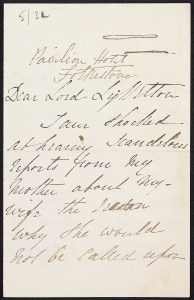
First page of a letter from Lord Sandys to Lord Lyttelton – Reference: 705:56 BA15492/160/2/51
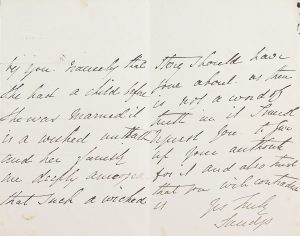
Second page of a letter from Lord Sandys to Lord Lyttelton – Reference: 705:56 BA15492/160/2/51
Although we know Pakington wrote to Lady Sandys regarding the ‘disparaging rumours’, it tells us something of the attitudes towards women and their place in nineteenth century British society, that it was discussed in great depth by ‘gentlemen’ in order to arrive at ‘truth and justice’.
“I conceive that one of the vital safeguards for the morality of our upper class…is the rule that no woman who has gone astray before marriage or after, shall ever again be received into society – I speak of actual and sufficiently established criminality…I conceive that a woman, who has unhappily so fallen, has made [a] gulf between herself and respectable society, and it is in her fault, though it may be also her misfortune, if that condition should be unfavourable to her.”
Lord Lyttelton, 26th August 1872
Reference Number: 705:56 BA15492/160/2/4
You can read a partial transcript of the letters, here: Sandys Affair Correspondence
Of the catalogued records already held in our collection that relate to the Sandys family of Ombersley, those from the English Civil War are particularly notable. Worcestershire has strong links to the Civil War – a series of mid-seventeenth century battles between the Royalists and the Parliamentarians that saw members of the titled family fight in opposition to one and other.
Of particular interest is Colonel Samuel Sandys (1615-1685) – the eldest son of Edwin Sandys MP for Droitwich (1591-1623) and Penelope (nee Bulkeley) (1586-1680) and an eminent supporter of Kings Charles I and II. Before the war, Samuel was himself an MP, yet at its outbreak he sided with the King – ensuring his exclusion from the House of Commons until Charles II, restored to the throne, appointed him MP for Worcestershire. Our archive holds handwritten letters to Samuel from his ‘assured friend’ Charles I. In one, written in September 1645 at Bridge North, the King assures ‘Sam Sandys’ of his good opinion of him:
‘Sam Sandys,
I am told that some malicious person both to you and my Service hath endeavoured to give you misapprehensions of my good opinion of you…Yet I have thought fit…to assure you in this particular way that there is no gentleman in England upon whose faithfulness and entire affections to my person and cause I do more confidently rely…and whenever it please God to restore me you shall be please to find the effects of my being your assured friend
Charles R’
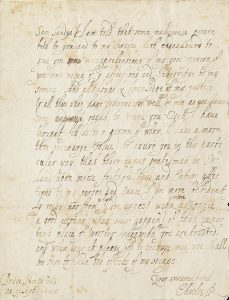
Letter to Colonel Samual Sandys from King Charles I, 30th September 1645 – Reference: x705:56 BA13825/1/12
In another, he writes that ‘whatsoever idle or malicious people tell you, be confident that I am, your assured friend’. In this second personal letter sent a few months later, ‘Sandys’ is asked to send what assistance he can to the Duke of Richmond.
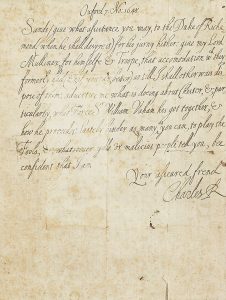
Letter to Colonel Samuel Sandys from King Charles I to Samuel Sandys, 7th November 1645 – Reference: x705:56 BA18325/1/11
‘Sam Sandys’ raised the best part of two Cavalier regiments during the Civil War. In 1643, he was commissioned by Prince Rupert to raise money to support his regiment of horse. Then in 1644, as Governor of Evesham, ‘the trusty and [well beloved] Colonell Sandys’ received an ‘order from the King’ for his regiment to be sent to Sir John Winter, to replace the forces withdrawn by Charles I in the Forest of Dean. Both of these documents we hold at The Hive.
Samuel fought at the Battle of Powick Bridge in opposition to his cousin, another Edwin Sandys – a fellow colonel but this time leader of the Roundheads, who was badly wounded and later died of his injuries. The victor at Powick, Samuel fought again at the Battle of Edgehill in 1642, where he was himself hurt and his brother Richard killed. He also commanded a troop in the Royalist march on Brentford. A year later, Samuel took command of the prestigious Worcester garrison that withstood siege by the Parliamentarian army. In 1645, he was commissioned by the King to become Governor of Worcester, which gave him the authority to slay any person that threatened the peace and security of the city and garrison of Worcester.
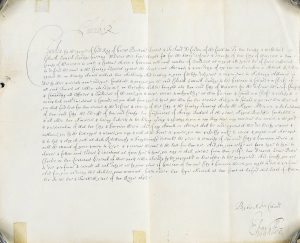
Commission from King Charles I to Colonell Samuell Sandys – Reference: x705:56 BA13825/1/10
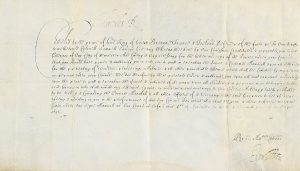
A handwritten letter from King Charles I to Sam Sandys regarding him becoming Governor of Worcester – Reference: x705:56 BA13825/1/9
Samuel’s brothers Martin and Henry Sandys were also Cavelier officers. Henry died of injuries sustained at the Battle of Cheriton, Hampshire, in 1644, and Martin was ordered by King Charles and the Council of War at Worcester to enlist the inhabitants of the city to his regiment; and to expel them from it if they refused. An order sent from Charles II to Earl Marshall of Carlise, concerns the precedency of Henry’s children. Dated 10th July 1673, it allowed them to succeed him following his death as the heir apparent to Edwin Sandys MP.
The involvement of members of the Sandys family in the English Civil War was significant, whether fighting in battles or mustering Royalist armies. Though they fought mainly in defence of English royalty, it is interesting that not all did. Perhaps we shall learn more of the story as we begin to catalogue the many records that make up the Sandys Archive.
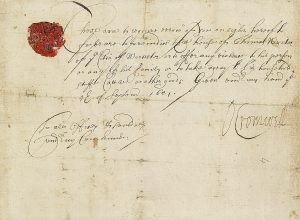
An order signed and sealed by Oliver Cromwell to not attack Thomas Winter, 4th September 1651 – Reference: x705:56 BA13825/1/13
If you’d like to view any of the records mentioned, please send us an ArchiveEnquiry or speak to a member of archive staff at Explore the Past on Level 2 of The Hive.
Fascinating finds
The Sandys Archive is a treasure trove of interesting records. So what have we found so far?
Sandys family photo album
It is likely this 19th century photo album was produced at least in part by the photocollage pioneer Mary Filmer (nee Sandys). Several of the photographs taken are of an exceptional quality, and although sparse, some photomontages are included. Where captions for photos are missing, it has been possible to identify some names and dates using other archival records. One reoccurring figure is Mary’s brother Augustus Frederick, 4th Baron Sandys, who appears alongside his sister, his wife Lady Augusta Sandys, and Mary’s husband Edmund Filmer.
Lady Mary Hill’s travel journal
Born in 1796, Lady Mary Hill was the youngest daughter of Mary Marchioness of Downshire and Baroness Sandys and Arthur Hill. In 1823, she embarked on a lengthy continental tour with her mother – travelling through France to Rome and Naples where her brother Augustus was living. This journal of Mary’s chronicles her trip and contains a remarkable collection of watercolour paintings, drawings and engraving belonging to the period. With German and Italian subject themes, one depicts the San Carol Theatre in Naples, where it’s likely the family attended the opera. It is possible these paintings are originals by Mary. Certainly, we know she took drawing lessons with her sister Charlotte, and had an interest in art.
The ladies’ drawing master Mr Payne once noted: ‘they draw with much freedom and dispatch. Are very fond of it.’
A note from cousin Florence
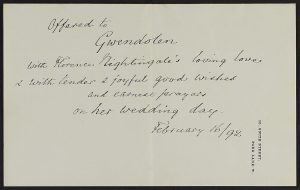
‘With Florence Nightingale’s loving love’, a note written by Nightingale in 1892 – Reference Number: 705:56 BA16936/44/2
This handwritten note from the founder of modern nursing Florence Nightingale offers a touching glimpse into her family ties!
Addressed to her goddaughter Gwendolen Trench-Gascoigne, it accompanied a wedding present. Gwendolen, was the mother of Lady Cynthia Sandys who married the 6th Lord Sandys. Her mother, Mary Ann Nicholson, was Florence’s first cousin.
A letter from Waterloo
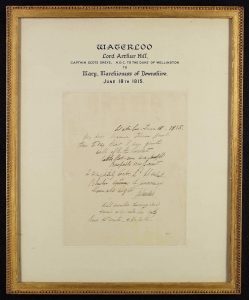
Letter from Lord Arthur Hill, 18th June 1815, mounted in gold frame – Reference: 705:56 BA16936
This letter, written by a young cavalry officer on the evening after the Battle of Waterloo, is a remarkable firsthand glimpse into one of history’s most famous battles. The officer in question is Arthur, later 2nd Baron Sandys in the 2nd creation. Known as ‘Atty’, he fought in the Duke of Wellington’s army. Scrawled in haste to his mother, Mary Marchioness of Downshire and Baroness Sandys, it reads:
Waterloo—June 18. 1815. My dear Mama I have just time to say that I am quite well after the hardest battle that ever was fought. Boneparte was present & completely beat.
The next day, in a second letter, he writes more fully:
Yesterday we fought the hardest battle that every yet was known, in which we obtained a most complete victory over the enemy […] The action began first about eight in the morning, by the french attacking our right…the enemy came down in great Force…sharp firing ensued, the Nassaus ran away, but were with difficulty rallied, the ground was taken & retaken several times. They then attacked the left & were repulsed by both Infantry & Cavalry […] it was a miracle the Duke & all of us were not all killed; he was everywhere, & led his troops on himself…Percy, myself had our horses wounded…The Dukes horse was not touched…I believe Percy takes the dispatches & will give you this.
Atty’s letters paint a vivid picture. Not only of the facts of war but of a personal need to reassure his mother waiting anxiously at home.
Fun fact: The Duke of Wellington was also Atty’s cousin!
Jane Austen’s nieces
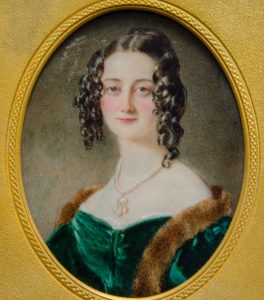
Cassandra Jane née Knight (1806-42) by Sir William Charles Ross RA, watercolour on ivory © Trustees of the Ombersley Conservation Trust
Jane Austen may not have been from Worcestershire, but she had strong connections with the County including that she was a relative of the Sandys family. Not one but two of her beloved nieces married Lord George Augusta Hill – the youngest son of Mary Marchioness of Downshire and Baroness Sandys.
Cassandra Jane and Louisa Knight were the daughters of Austen’s brother Edward, who changed his surname when he inherited the estates of Godmersham and Chawton. Louisa was also Jane’s Goddaughter.
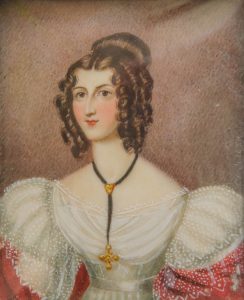
Louisa Knight, 1830, painting © Trustees of the Ombersley Conservation Trust
Cassandra and George married in 1834. They had four children, but Cassandra died after the birth of the fourth. Her sister ‘Lou’ moved from England to take care of her nieces and nephews, and in 1847, George and Louisa married. Two years later, they had a son of their own.
Austen died when her youngest niece was only ten but is said to have written of her, ‘I always loved Cassandra, for her fine dark eyes and sweetness of her temperament’. In the archive is a letter written by Fanny Rice, Dowager Countess of Winchilsea to George and Cassandra’s eldest son in which she tells the story of the couple’s courtship. Written nearly 70 years after their wedding, it includes a sketch by Fanny of her ‘Aunt Cass’.
“[Y]our Father and Mother used to walk about hand in hand…so joyful & full of fun!…I went to the wedding dinner the evening before where members of both families were entertained by Grandpapa”
‘Grandpapa’ is Edward Knight.
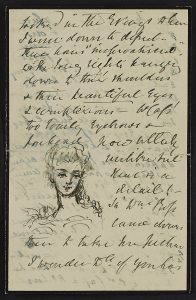
Extract from letter written by Fanny Rice to Captain Arthur Blundell George Sandys Hill, 24 February 1904 – 705:56/BA16936
Sandys women
Although much of history has been written about men, by men, it is full of examples of remarkable women. More than just wives, mothers and daughters, many lived fascinating lives but their stories went unrecorded and untold. Material in the Sandys Archive sheds light on some impressive individuals.
Mary Georgiana Carolina Sandys (1878-1916) was the daughter of Arthur Marcus Cecil Hill, 3rd Baron Sandys and the elder sister of 4th Baron, Augustus Fredrick Arthur. She was also a pioneer in the art of photocollage.
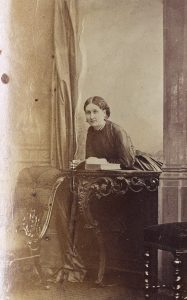
Honourable Lady Mary Filmer, Sandys family photo album, 18th cent – Reference: BA16936
A common practice of aristocratic women in Victorian England, photocollage saw armature artists cut and paste photos into elaborate watercolour scenes to produce new images and meanings. Lady Mary’s showcased a skill and wit with which she was able to climb the social ladder. Having grown up in political circles, she was active in London society – organising musical soirees and parties at the country homes she shared with her husband, Edmund.
Mary left a legacy of albums, her most notable of which featured prominently in the exhibition ‘Playing With Pictures: The Art of Victorian Photocollage’ which travelled to the Metropolitan Museum of Art, New York, in 2010. The story goes that this ‘Filmer Album’ was stolen from the family before happily coming up for auction at Christies in 1978. Donated by its buyer, it now sits in the collection of the Fogg Museum in Harvard.
Begun in 1862, the ornate volume contains watercolour collages and albumen silver prints. In one collage, Mary stands in her drawing room next to the large figure of Albert Edward Prince of Wales, with whom she was said to have enjoyed a well-known flirtation despite her marriage. Perhaps it is telling then that Edmund appears, in contrast, smaller and in the bottom corner of the work next to the couple’s dog. On another page, Augustus Fredrick is shown dressed in a lounge suit – the latest fashion at the time.
Mary’s contribution to the Sandys Archive includes several family photographs (of which she was a collector) and some impressive early portraits. Pages from the album exhibited at The Met are identical to those in family photo albums held in the collection. Enhanced with artwork, it therefore seems likely Mary was responsible for at least some of the photomontages within it. Though she may not have been considered an artist in her lifetime, today we recognise the skill and creativity that would have made Mary one.
To view pages from the Sandys family photo album, see Fascinating Finds above
Born Cynthia Gascoigne, Cynthia Sandys, wife of 6th Baron Arthur Fitzgerald Sandys Hill, was more than a woman of means and fortunate family connections. She had a variety of interests. She studied physics and chemistry at Leeds University, worked as a nurse during the First World War and as Justice of the Peace. She loved parties and had an interest in politics, sitting as a Magistrate and as Chair of the local Conservative Association. On her mother’s side, Ida Copeland – one of the earliest women MPs – was her cousin. Ida won her seat in 1931 standing against Sir Oswald Mosely – founder of the British Fascist Party.
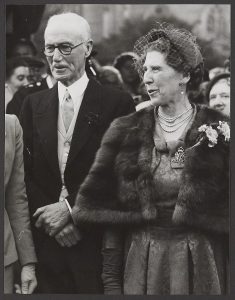
Lord Arthur FitzGerald Sandys Hill and Lady Cynthia Sandys at their daughter’s wedding, 1954 – Reference: 899:156 WPS5183
Cynthia worked hard for the St John’s Ambulance, Women’s Institute and Girl Guides, but her claim to fame was as a Medium. Known for her ability to channel letters from deceased family members and acquaintances, she first turned to spiritualism following the deaths of her father, and brother in law, Richard. Material relating to Cynthia in the Sandys Archive, includes letters written by her husband Arthur to the couple’s son (also called Richard) in which he refers to Cythina’s abilities as a Clairaudience. Often considered a form on clairvoyance, clairaudience is the ability to hear voices from the spirit world.
In one letter, Arthur reports that Cynthia had been in touch with his ‘dear’ deceased brother:
‘He said that, on leaving his body, he found himself standing beside it and he said Good gracious – Artie was right; I must go and find him, and tell him…I’m not sensitive, so I didn’t feel his presence. It was a most merciful release.’
In 1957, Cynthia and Arthur’s eldest daughter Patricia died, but Cynthia’s gift meant she remained in contact. Arthur’s letters tell us more:
‘Now here’s a queer thing. Your Mother was in the Hall the other day and heard someone calling. It wasn’t my voice, but she came up to enquire, and I denied all knowledge. When writing the next day, Pat explained that she was able to make her voice heard because your Mother was so completely surrounded by wood […] She said it was a great thrill for her, but it was an even better one for her Mama, who got gooseflesh all over and recognised (but disbelieved) the intonation.’
Over a ten year period, Cynthia collected a series of letters from ‘Pat’ – an extensive selection of which she published in the book Letters from our daughters – a copy of which can be found in our Local Studies Reference Library. In it, Pat refers often to her cousin ‘Flo’, as in Florence Nightingale, Cynthia’s first cousin twice removed.
Arthur, too, had an interest in spiritualism. Despite some scepticism, in about 1930 he had himself began attending psychic sessions. ‘I rang up the Little Marchioness [Mary, Marchioness of Downshire and Baroness Sandys] several times’ he writes to Richard, ‘It was quite a new affair calling up someone who passed away in 1835’.
‘Letters from our daughters’, volumes one and two can be found at shelfmark 133.90924 in the Local Studies Reference Library on Level 2 of The Hive
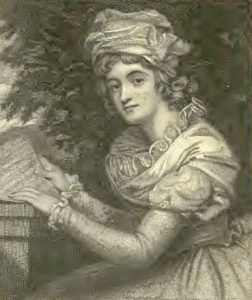
Melesina Trench by Francis Holl after George Romney, engraving, published 1862 © Trustees of the Ombersley Conservation Trust
‘She is a travelled person […] very agreeable’ – from the Journal of Ladies Charlotte and Mary Hill
More than an Irish society beauty, Melesina Trench nee Chenevix (1768-1827) was a writer, poet and diarist. Yet it was not until her sons published her work posthumously that she became known for this. She spoke English, French, German and Italian, loved reading and mastered Shakespeare by the age of seven.
She married twice and when her first husband died, travelled extensively – starting a journal that she kept throughout her life. While not every volume survives, several were published in the book ‘The Remains of the Late Mrs Richard Trench’. Her original journal from 1824 – much of it unpublished – is held in the Sandys Archive. It contains many literary references, humorous criticisms, strong opinions and social concerns.
Melesina’s travels began in 1799 when she sailed to Hamburg to meet Lady Edward Fitzgerald and her ‘loveliest little daughter’ Pamela. ‘Pam’ was the second cousin of George Augusta Hill and an admirer of his second wife Louisa’s ‘Aunt Jane’. Melesina travelled on to Brunswick, Dresden, Prague and Vienna before returning for a short while to Ireland.
In Dresden, she befriended the British minister High Elliot. They were playing chess when Sir William Hamilton and Cornelia Knight arrived with ‘little’ Lord Nelson and Emma Hamilton (whose scandalous love affair both shocked and captivated Georgian society). In Berlin, Melesina met Napoleon’s brother Lucien Bonaparte – a ‘remarkably serious’ man. ‘His whiskers cover half of each cheek and add to the dinginess of his appearance’, she wrote.
Later, Melesina travelled to Paris where she met and married Richard Trench. Following a breakdown in peace during the Napoleonic Wars, the newlyweds were forced to live in France for five years. The couple had six children, three of whom sadly died in childhood. Melesina’s son Charles was the recipient of many of his mother’s interesting letters. Including one sent three months after the Battle of Waterloo in which she wrote that ‘the material of future history are forming’.
Perhaps unsurprisingly, Melesina had many friends in common with Mary Marchioness of Downshire and Baroness Sandys. Both moved in the social circle of the then Prince of Wales, though Melesina’s journal tells us she was rather less fond of him. Her other famous friends included the celebrated Ladies of Llangollen, the Duke of Wellington and the politician Lord Castlereagh.
‘Journal belonging to Melesina Trench’ – Reference: 705:56 BA16936/41/2(i-ii)
Want to know more?
Check out our latest blogs:
Introducing the Sandys Family of Ombersley, Part One
Introducing the Sandys Family of Ombersley, Part Two
Three Little Mice in a Grand World: The Journals of Charlotte and Mary Hill, Part One
Three Little Mice in a Grand World: The Journals of Charlotte and Mary Hill, Part Two
Lord Sandys’ letters from the Peninsular War
Find out more about the Sandys’ Story
